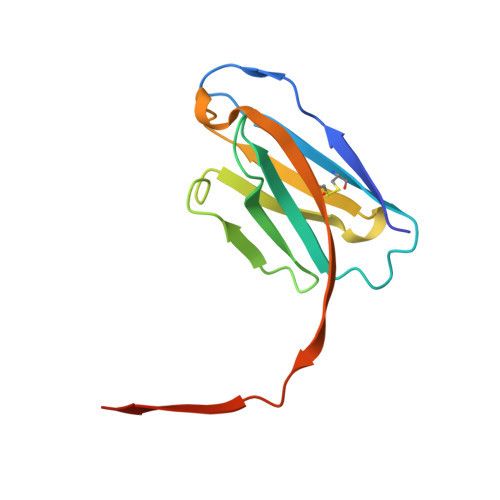Identification and biophysical characterization of a novel domain-swapped camelid antibody specific for fentanyl.
Gallant, J.P., Hicks, D., Shi, K., Moeller, N.H., Hoppe, B., Lake, E.W., Baehr, C., Pravetoni, M., Aihara, H., LeBeau, A.M.(2024) J Biol Chem 300: 107502-107502
- PubMed: 38945452
- DOI: https://doi.org/10.1016/j.jbc.2024.107502
- Primary Citation of Related Structures:
8V9W, 8V9X, 8V9Y, 8V9Z, 8VA0 - PubMed Abstract:
Opioid use disorders (OUD) and overdoses are ever-evolving public health threats that continue to grow in incidence and prevalence in the United States and abroad. Current treatments consist of opioid receptor agonists and antagonists, which are safe and effective but still suffer from some limitations. Murine and humanized monoclonal antibodies (mAb) have emerged as an alternative and complementary strategy to reverse and prevent opioid-induced respiratory depression. To explore antibody applications beyond traditional heavy-light chain mAbs, we identified and biophysically characterized a novel single-domain antibody specific for fentanyl from a camelid variable-heavy-heavy (VHH) domain phage display library. Structural data suggested that VHH binding to fentanyl was facilitated by a unique domain-swapped dimerization mechanism, which accompanied a rearrangement of complementarity-determining region loops leading to the formation of a fentanyl-binding pocket. Structure-guided mutagenesis further identified an amino acid substitution that improved the affinity and relaxed the requirement for dimerization of the VHH in fentanyl binding. Our studies demonstrate VHH engagement of an opioid and inform on how to further engineer a VHH for enhanced stability and efficacy, laying the groundwork for exploring the in vivo applications of VHH-based biologics against OUD and overdose.
Organizational Affiliation:
Department of Pathology and Laboratory Medicine, University of Wisconsin School of Medicine and Public Health, Madison, Wisconsin, USA.
















